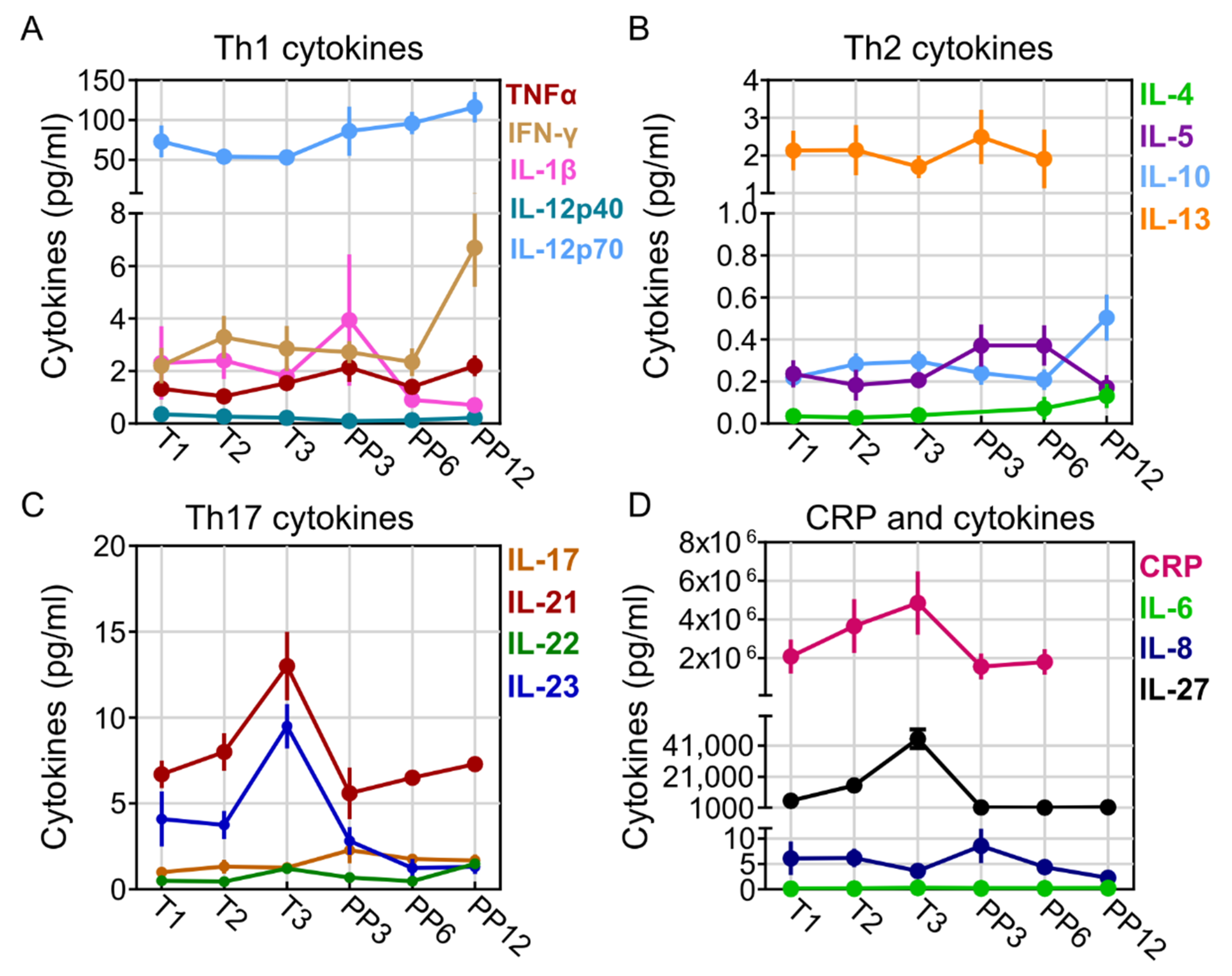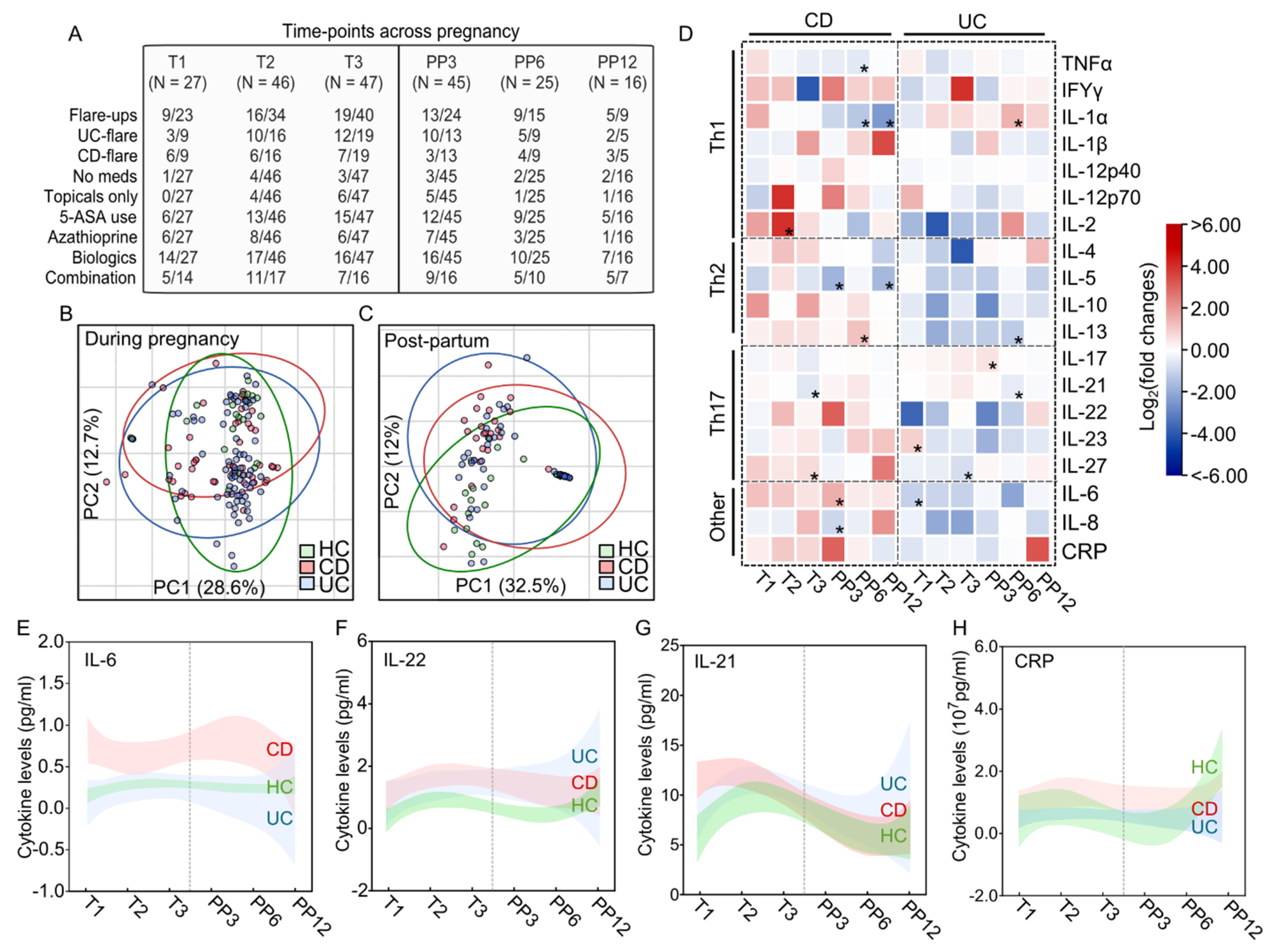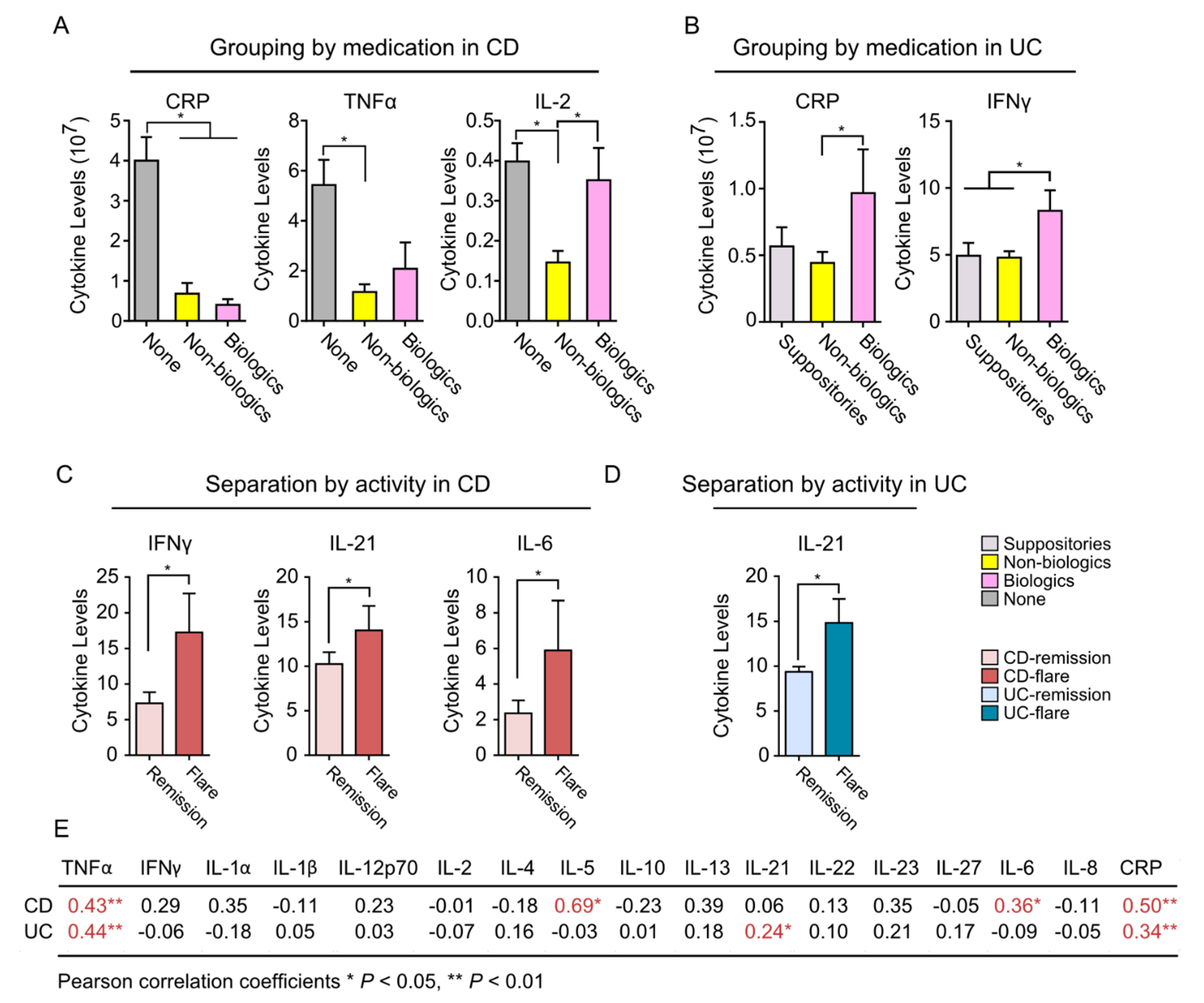Elevated IL-6 and IL-22 in Early Pregnancy Are Associated with Worse Disease Course in Women with Inflammatory Bowel Disease
Abstract
:1. Introduction
2. Results
2.1. Baseline Demographics and Clinical Characteristics
2.2. Pregnancy-Related Changes in Th1, Th2, and Th17 Cytokines
2.3. Serum Cytokine Changes by IBD during Pregnancy
2.4. Difference in Serum Cytokines between Pre-Partum and Post-Partum Periods
2.5. Serum Cytokine Expressions Stratified by Medications and Disease Activity during Pregnancy
2.6. Impact of T1 Cytokines on Course of IBD and Pregnancy-Related Outcomes
3. Discussion
4. Materials and Methods
4.1. Study Design and Study Cohort
4.2. Cohort Follow-Up
4.3. Baseline Visits
4.4. Follow-Up Visits
4.5. Maternal FCP
4.6. Maternal Cytokine Panel
4.7. Statistical Analysis
4.8. Study Approval
4.9. Data Availability
5. Conclusions
Supplementary Materials
Author Contributions
Funding
Institutional Review Board Statement
Informed Consent Statement
Data Availability Statement
Acknowledgments
Conflicts of Interest
References
- de Souza, H.S.P.; Fiocchi, C. Immunopathogenesis of IBD: Current state of the art. Nat. Rev. Gastroenterol. Hepatol. 2016, 13, 13–27. [Google Scholar] [CrossRef] [PubMed]
- Nguyen, G.C.; Seow, C.H.; Maxwell, C.; Huang, V.; Leung, Y.; Jones, J.; Leontiadis, G.I.; Tse, F.; Mahadevan, U.; van der Woude, C.J.; et al. The Toronto Consensus Statements for the Management of Inflammatory Bowel Disease in Pregnancy. Gastroenterology 2016, 150, 734–757.e1. [Google Scholar] [CrossRef] [PubMed]
- Trowsdale, J.; Betz, A.G. Mother’s little helpers: Mechanisms of maternal-fetal tolerance. Nat. Immunol. 2006, 7, 241–246. [Google Scholar] [CrossRef]
- Riis, L.; Vind, I.; Politi, P.; Wolters, F.; Vermeire, S.; Tsianos, E.; Freitas, J.; Mouzas, I.; Ruiz Ochoa, V.; O’Morain, C.; et al. Does pregnancy change the disease course? A study in a European cohort of patients with inflammatory bowel disease. Am. J. Gastroenterol. 2006, 101, 1539–1545. [Google Scholar] [CrossRef]
- Reddy, D.; Murphy, S.J.; Kane, S.V.; Present, D.H.; Kornbluth, A.A. Relapses of inflammatory bowel disease during pregnancy: In-hospital management and birth outcomes. Am. J. Gastroenterol. 2008, 103, 1203–1209. [Google Scholar] [CrossRef] [PubMed]
- Schulze, H.; Esters, P.; Dignass, A. Review article: The management of Crohn’s disease and ulcerative colitis during pregnancy and lactation. Aliment. Pharmacol. Ther. 2014, 40, 991–1008. [Google Scholar] [CrossRef]
- Abhyankar, A.; Ham, M.; Moss, A.C. Meta-analysis: The impact of disease activity at conception on disease activity during pregnancy in patients with inflammatory bowel disease. Aliment. Pharmacol. Ther. 2013, 38, 460–466. [Google Scholar] [CrossRef] [PubMed]
- Leung, K.K.; Tandon, P.; Govardhanam, V.; Maxwell, C.; Huang, V. The Risk of Adverse Neonatal Outcomes With Maternal Inflammatory Bowel Disease: A Systematic Review and Meta-analysis. Inflamm. Bowel Dis. 2021, 27, 550–562. [Google Scholar] [CrossRef]
- Schett, G.; McInnes, I.B.; Neurath, M.F. Reframing Immune-Mediated Inflammatory Diseases through Signature Cytokine Hubs. N. Engl. J. Med. 2021, 385, 628–639. [Google Scholar] [CrossRef]
- Hovhannisyan, Z.; Treatman, J.; Littman, D.R.; Mayer, L. Characterization of Interleukin-17–Producing Regulatory T Cells in Inflamed Intestinal Mucosa From Patients With Inflammatory Bowel Diseases. Gastroenterology 2011, 140, 957–965. [Google Scholar] [CrossRef] [Green Version]
- Neurath, M.F.; Finotto, S.; Glimcher, L.H. The role of Th1/Th2 polarization in mucosal immunity. Nat. Med. 2002, 8, 567–573. [Google Scholar] [CrossRef] [PubMed]
- Mor, G.; Aldo, P.; Alvero, A.B. The unique immunological and microbial aspects of pregnancy. Nat. Rev. Immunol. 2017, 17, 469–482. [Google Scholar] [CrossRef]
- van der Giessen, J.; Huang, V.W.; van der Woude, C.J.; Fuhler, G.M. Modulatory Effects of Pregnancy on Inflammatory Bowel Disease. Clin. Transl. Gastroenterol. 2019, 10, e00009. [Google Scholar] [CrossRef]
- Dunsmore, G.; Koleva, P.; Ghobakhloo, N.; Sutton, R.; Ambrosio, L.; Meng, X.; Hotte, N.; Nguyen, V.; Madsen, K.L.; Dieleman, L.A.; et al. Lower Abundance and Impaired Function of CD71+ Erythroid Cells in Inflammatory Bowel Disease Patients During Pregnancy. J. Crohns Colitis 2019, 13, 230–244. [Google Scholar] [CrossRef]
- Delyea, C.; Bozorgmehr, N.; Koleva, P.; Dunsmore, G.; Shahbaz, S.; Huang, V.; Elahi, S. CD71+ Erythroid Suppressor Cells Promote Fetomaternal Tolerance through Arginase-2 and PDL-1. J. Immunol. 2018, 200, 4044–4058. [Google Scholar] [CrossRef] [PubMed]
- Rodríguez-Perlvárez, M.L.; García-Sánchez, V.; Villar-Pastor, C.M.; González, R.; Iglesias-Flores, E.; Muntane, J.; Gómez-Camacho, F. Role of Serum Cytokine Profile in Ulcerative Colitis Assessment. Inflamm. Bowel Dis. 2012, 18, 1864–1871. [Google Scholar] [CrossRef]
- Korolkova, O.Y.; Myers, J.N.; Pellom, S.T.; Wang, L.; M’Koma, A.E. Characterization of Serum Cytokine Profile in Predominantly Colonic Inflammatory Bowel Disease to Delineate Ulcerative and Crohn’s Colitides. Clin. Med. Insights Gastroenterol. 2015, 8, 29–44. [Google Scholar] [CrossRef] [PubMed]
- Tatsuki, M.; Hatori, R.; Nakazawa, T.; Ishige, T.; Hara, T.; Kagimoto, S.; Tomomasa, T.; Arakawa, H.; Takizawa, T. Serological cytokine signature in paediatric patients with inflammatory bowel disease impacts diagnosis. Sci. Rep. 2020, 10, 14638. [Google Scholar] [CrossRef]
- van der Giessen, J.; Binyamin, D.; Belogolovski, A.; Frishman, S.; Tenenbaum-Gavish, K.; Hadar, E.; Louzoun, Y.; Peppelenbosch, M.P.; van der Woude, C.J.; Koren, O.; et al. Modulation of cytokine patterns and microbiome during pregnancy in IBD. Gut 2020, 69, 473–486. [Google Scholar] [CrossRef]
- Ghosh, S.; Chaudhary, R.; Carpani, M.; Playford, R. Interfering with interferons in inflammatory bowel disease. Gut 2006, 55, 1071–1073. [Google Scholar] [CrossRef]
- Holtkamp, W.; Stollberg, T.; Reis, H.E. Serum interleukin-6 is related to disease activity but not disease specificity in inflammatory bowel disease. J. Clin. Gastroenterol. 1995, 20, 123–126. [Google Scholar] [CrossRef] [PubMed]
- Fantini, M.C.; Monteleone, G.; MacDonald, T.T. IL-21 comes of age as a regulator of effector T cells in the gut. Mucosal Immunol. 2008, 1, 110–115. [Google Scholar] [CrossRef] [PubMed]
- Holm, T.L.; Tornehave, D.; Søndergaard, H.; Kvist, P.H.; Sondergaard, B.-C.; Hansen, L.; Hermit, M.B.; Holgersen, K.; Vergo, S.; Frederiksen, K.S.; et al. Evaluating IL-21 as a Potential Therapeutic Target in Crohn’s Disease. Gastroenterol. Res. Pract. 2018, 2018, 5962624. [Google Scholar] [CrossRef]
- Yu, J.; He, S.; Liu, P.; Hu, Y.; Wang, L.; Wang, X.; Han, Y.; Zhu, X. Interleukin-21 promotes the development of ulcerative colitis and regulates the proliferation and secretion of follicular T helper cells in the colitides microenvironment. Mol. Med. Rep. 2015, 11, 1049–1056. [Google Scholar] [CrossRef]
- Yamamoto-Furusho, J.K.; Miranda-Pérez, E.; Fonseca-Camarillo, G.; Sánchez-Muñoz, F.; Barreto-Zuñiga, R.; Dominguez-Lopez, A. Interleukin 21 Expression is Increased in Rectal Biopsies from Patients with Ulcerative Colitis. Inflamm. Bowel Dis. 2010, 16, 1090. [Google Scholar] [CrossRef]
- Li, L.-J.; Gong, C.; Zhao, M.-H.; Feng, B.-S. Role of interleukin-22 in inflammatory bowel disease. World J. Gastroenterol. WJG 2014, 20, 18177–18188. [Google Scholar] [CrossRef]
- Zhang, N.; Pan, H.-F.; Ye, D.-Q. Th22 in inflammatory and autoimmune disease: Prospects for therapeutic intervention. Mol. Cell. Biochem. 2011, 353, 41–46. [Google Scholar] [CrossRef]
- Song, X.; Zhu, S.; Shi, P.; Liu, Y.; Shi, Y.; Levin, S.D.; Qian, Y. IL-17RE is the functional receptor for IL-17C and mediates mucosal immunity to infection with intestinal pathogens. Nat. Immunol. 2011, 12, 1151–1158. [Google Scholar] [CrossRef]
- Schulz, S.M.; Köhler, G.; Schütze, N.; Knauer, J.; Straubinger, R.K.; Chackerian, A.A.; Witte, E.; Wolk, K.; Sabat, R.; Iwakura, Y.; et al. Protective immunity to systemic infection with attenuated Salmonella enterica serovar enteritidis in the absence of IL-12 is associated with IL-23-dependent IL-22, but not IL-17. J. Immunol. Baltim. Md. 1950 2008, 181, 7891–7901. [Google Scholar] [CrossRef]
- Raffatellu, M.; George, M.D.; Akiyama, Y.; Hornsby, M.J.; Nuccio, S.-P.; Paixao, T.A.; Butler, B.P.; Chu, H.; Santos, R.L.; Berger, T.; et al. Lipocalin-2 Resistance Confers an Advantage to Salmonella enterica Serotype Typhimurium for Growth and Survival in the Inflamed Intestine. Cell Host Microbe 2009, 5, 476–486. [Google Scholar] [CrossRef] [PubMed] [Green Version]
- Keir, M.E.; Yi, T.; Lu, T.T.; Ghilardi, N. The role of IL-22 in intestinal health and disease. J. Exp. Med. 2020, 217, e20192195. [Google Scholar] [CrossRef]
- Sands, B.E. Biomarkers of Inflammation in Inflammatory Bowel Disease. Gastroenterology 2015, 149, 1275–1285.e2. [Google Scholar] [CrossRef]
- Sands, B.E.; Chen, J.; Feagan, B.G.; Penney, M.; Rees, W.A.; Danese, S.; Higgins, P.D.R.; Newbold, P.; Faggioni, R.; Patra, K.; et al. Efficacy and Safety of MEDI2070, an Antibody Against Interleukin 23, in Patients With Moderate to Severe Crohn’s Disease: A Phase 2a Study. Gastroenterology 2017, 153, 77–86.e6. [Google Scholar] [CrossRef] [PubMed]
- Allocca, M.; Jovani, M.; Fiorino, G.; Schreiber, S.; Danese, S. Anti-IL-6 Treatment for Inflammatory Bowel Diseases: Next Cytokine, Next Target. Curr. Drug Targets 2013, 14, 1508–1521. [Google Scholar] [CrossRef]
- Danese, S.; Vermeire, S.; Hellstern, P.; Panaccione, R.; Rogler, G.; Fraser, G.; Kohn, A.; Desreumaux, P.; Leong, R.W.; Comer, G.M.; et al. Randomised trial and open-label extension study of an anti-interleukin-6 antibody in Crohn’s disease (ANDANTE I and II). Gut 2019, 68, 40–48. [Google Scholar] [CrossRef]
- Prins, J.R.; Gomez-Lopez, N.; Robertson, S.A. Interleukin-6 in pregnancy and gestational disorders. J. Reprod. Immunol. 2012, 95, 1–14. [Google Scholar] [CrossRef]
- Heidari, Z.; Moudi, B.; Sheibak, N.; Asemi-Rad, A.; Keikha, N.; Mahmoudzadeh-Sagheb, H.; Ghasemi, M. Interleukin 22 Expression During the Implantation Window in the Endometrium of Women with Unexplained Recurrent Pregnancy Loss and Unexplained Infertility Compared to Healthy Parturient Individuals. J. Interferon Cytokine Res. 2021, 41, 461–468. [Google Scholar] [CrossRef] [PubMed]
- Sproston, N.R.; Ashworth, J.J. Role of C-Reactive Protein at Sites of Inflammation and Infection. Front. Immunol. 2018, 9, 754. [Google Scholar] [CrossRef]
- Watts, D.H.; Krohn, M.A.; Wener, M.H.; Eschenbach, D.A. C-reactive protein in normal pregnancy. Obstet. Gynecol. 1991, 77, 176–180. [Google Scholar] [CrossRef] [PubMed]
- von Versen-Hoeynck, F.M.; Hubel, C.A.; Gallaher, M.J.; Gammill, H.S.; Powers, R.W. Plasma Levels of Inflammatory Markers Neopterin, Sialic Acid, and C-Reactive Protein in Pregnancy and Preeclampsia. Am. J. Hypertens. 2009, 22, 687–692. [Google Scholar] [CrossRef] [Green Version]
- Pitiphat, W.; Gillman, M.W.; Joshipura, K.J.; Williams, P.L.; Douglass, C.W.; Rich-Edwards, J.W. Plasma C-Reactive Protein in Early Pregnancy and Preterm Delivery. Am. J. Epidemiol. 2005, 162, 1108–1113. [Google Scholar] [CrossRef]
- Vecchié, A.; Bonaventura, A.; Carbone, F.; Maggi, D.; Ferraiolo, A.; Carloni, B.; Andraghetti, G.; Affinito Bonabello, L.; Liberale, L.; Dallegri, F.; et al. C-Reactive Protein Levels at the Midpregnancy Can Predict Gestational Complications. BioMed Res. Int. 2018, 2018, e1070151. [Google Scholar] [CrossRef] [PubMed]
- Ridker, P.M. From CRP to IL-6 to IL-1: Moving Upstream To Identify Novel Targets for Atheroprotection. Circ. Res. 2016, 118, 145–156. [Google Scholar] [CrossRef] [PubMed]
- Seow, C.H.; Leung, Y.; Novak, K.L. Towards Routine Non-invasive Monitoring of Disease Activity Using Gastrointestinal Ultrasound and Faecal Calprotectin in Pregnant Women With IBD. J. Crohns Colitis 2020, 14, 1790–1791. [Google Scholar] [CrossRef]
- Wei, S.-C.; Tung, C.-C.; Weng, M.-T.; Wong, J.-M. Experience of patients with inflammatory bowel disease in using a home fecal calprotectin test as an objective reported outcome for self-monitoring. Intest. Res. 2018, 16, 546–553. [Google Scholar] [CrossRef]
- Wu, R.Y.; Tandon, P.; Ambrosio, L.; Dunsmore, G.; Hotte, N.; Dieleman, L.A.; Elahi, S.; Madsen, K.; Huang, V. Post-neonatal Outcomes of Infants Born to Women with Active Trimester One Inflammatory Bowel Disease: A Pilot Study. Dig. Dis. Sci. 2022, 1–10. [Google Scholar] [CrossRef] [PubMed]
- Meng, X.; Dunsmore, G.; Koleva, P.; Elloumi, Y.; Wu, R.Y.; Sutton, R.T.; Ambrosio, L.; Hotte, N.; Nguyen, V.; Madsen, K.L.; et al. The Profile of Human Milk Metabolome, Cytokines, and Antibodies in Inflammatory Bowel Diseases Versus Healthy Mothers, and Potential Impact on the Newborn. J. Crohns Colitis 2019, 13, 431–441. [Google Scholar] [CrossRef]
- Chen, C.; Chen, H.; Zhang, Y.; Thomas, H.R.; Frank, M.H.; He, Y.; Xia, R. TBtools: An Integrative Toolkit Developed for Interactive Analyses of Big Biological Data. Mol. Plant 2020, 13, 1194–1202. [Google Scholar] [CrossRef]





| Healthy (N = 11) | CD (N = 29) | UC (N = 47) | p-Value | |
|---|---|---|---|---|
| Age at conception (± SD) | 31 ± 1.6 | 31 ± 4.7 | 30 ± 5.0 | 0.55 ‡ |
| Age of diagnosis (± SD) | - | 23 ± 6.1 | 23 ± 6.7 | 0.97 ‡ |
| Marital Status | 0.09 † | |||
| Common-law | 2/11 (18%) | 10/27 (37%) | 6/43 (14%) | |
| Married | 9/11 (82%) | 15/27 (56%) | 28/43 (65%) | |
| Single | 0/11 (0%) | 0/27 (0%) | 3/43 (7%) | |
| Ethnicity | 0.52 † | |||
| Caucasian | 5/11 (45%) | 22/27 (82%) | 33/43 (77%) | |
| South Asian | 1/11 (9%) | 0/27 (0%) | 2/43 (5%) | |
| Employment | 0.65 † | |||
| Full-time | 8/11 (73%) | 16/27 (59%) | 27/43 (63%) | |
| Part-time | 3/11 (27%) | 3/27 (11%) | 2/43 (5%) | |
| Education | 0.78 † | |||
| High school | 0/11 (0%) | 6/27 (22%) | 7/43 (16%) | |
| Trades | 0/11 (0%) | 8/27 (30%) | 11/43 (26%) | |
| University | 6/11 (55%) | 11/27 (41%) | 19/43 (44%) | |
| Smoking status | 0.88 † | |||
| Ex-smoker | 2/11 (18%) | 12/27 (44%) | 19/43 (44%) | |
| Alcohol use | 0.68 † | |||
| Ex-drinker | 5/11 (45%) | 17/27 (63%) | 28/43 (65%) | |
| Never | 6/11 (55%) | 7/27 (26%) | 9/43 (21%) | |
| Clinical flare-up | - | 5/28 (18%) | 24/40 (60%) | 0.02 † |
| Biochemical flare-up | - | 12/20 (60%) | 19/36 (53%) | 0.84 † |
| Prior pregnancies | 4/10 (40%) | 15/27 (55%) | 29/46 (63%) | 0.55 † |
| Prior miscarriages | 0/4 (0%) | 8/15 (53%) | 14/29 (48%) | 0.16 † |
| Prior elective abortions | 1/4 (25%) | 1/15 (7%) | 1/29 (3%) | 0.24 † |
| Prior preterm delivery | 0/4 (0%) | 0/15 (0%) | 0/29 (0%) | - |
| Prior pre-eclampsia | 0/4 (0%) | 2/15 (13%) | 0/29 (0%) | 0.10 † |
| Prior placenta previa | 0/4 (0%) | 0/15 (0%) | 1/29 (3%) | 0.72 † |
| Prior PROM | 0/4 (0%) | 0/15 (0%) | 0/29 (0%) | - |
| Pregnancy Outcomes | CD (N = 29) | UC (N = 47) | p-Value |
|---|---|---|---|
| Preterm birth | 3/29 (10%) | 7/47 (15%) | 0.57 † |
| Vaginal deliveries | 10/29 (34%) | 26/43 (60%) | 0.10 † |
| C-section deliveries | 19/29 (66%) | 17/43 (39%) | 0.10 † |
| Induced labor | 2/24 (8%) | 11/43 (25%) | 0.06 † |
| Failed vaginal deliveries | 2/24 (8%) | 4/43 (9%) | 0.80 † |
| Emergency C-sections | 8/24 (24%) | 10/47 (23%) | 0.82 † |
| Planned C-sections | 11/29 (38%) | 7/47 (15%) | 0.10 † |
| Assisted deliveries | 0/29 (0%) | 2/47 (4%) | 0.96 † |
| Placental hemorrhage | 0/29 (0%) | 1/47 (2%) | 0.72 † |
| Congenital anomalies | 0/29 (0%) | 1/47 (2%) | 0.72 † |
| Neonatal infections | 1/29 (3%) | 0/47 (0%) | 0.43 † |
| Spontaneous abortions | 1/29 (3%) | 1/47 (2%) | 0.96 † |
| Pre-eclampsia | 3/29 (10%) | 0/47 (0%) | 0.02 † |
| Placental previa | 0/29 (0%) | 0/47 (0%) | - |
| PROM | 2/28 (7%) | 6/47 (13%) | 0.56 † |
| PPROM | 2/28 (7%) | 6/47 (13%) | 0.56 † |
| Placental abruptions | 1/28 (3%) | 0/47 (0%) | 0.43 † |
| Chorioamnionitis | 1/25 (4%) | 1/47 (2%) | 0.43 † |
| Gestational diabetes | 1/29 (3%) | 1/47 (2%) | 0.93 † |
| Venous thromboembolism | 0/29 (0%) | 0/47 (0%) | - |
| Medications | CD (N = 29) | UC (N = 47) |
|---|---|---|
| 5-ASA use Salofalk® (2–4 g daily) Pentasa® (4 g daily) Mezavant® (1.2–2.4 g daily) Asacol® (1.6–4.8 g daily) | 1/26 (4%) 0/26 (0%) 1/26 (4%) 0/26 (0%) | 15/47 (32%) 5/47 (11%) 6/47 (13%) 7/47 (15%) |
| Immunosuppressants Corticosteroids Imuran® (150 mg daily) | 1/26 (4%) 4/26 (16%) | 0/47 (0%) 3/47 (6%) |
| Biologic use Infliximab Adalimumab Vedolizumab | 5/26 (26%) 4/26 (0%) 0/26 (0%) | 4/47 (9%) 2/47 (4%) 1/47 (2%) |
Publisher’s Note: MDPI stays neutral with regard to jurisdictional claims in published maps and institutional affiliations. |
© 2022 by the authors. Licensee MDPI, Basel, Switzerland. This article is an open access article distributed under the terms and conditions of the Creative Commons Attribution (CC BY) license (https://creativecommons.org/licenses/by/4.0/).
Share and Cite
Wu, R.Y.; Xiao, K.; Hotte, N.; Tandon, P.; Elloumi, Y.; Ambrosio, L.; Dunsmore, G.; Elahi, S.; Kroeker, K.I.; Dieleman, L.A.; et al. Elevated IL-6 and IL-22 in Early Pregnancy Are Associated with Worse Disease Course in Women with Inflammatory Bowel Disease. Int. J. Mol. Sci. 2022, 23, 10281. https://doi.org/10.3390/ijms231810281
Wu RY, Xiao K, Hotte N, Tandon P, Elloumi Y, Ambrosio L, Dunsmore G, Elahi S, Kroeker KI, Dieleman LA, et al. Elevated IL-6 and IL-22 in Early Pregnancy Are Associated with Worse Disease Course in Women with Inflammatory Bowel Disease. International Journal of Molecular Sciences. 2022; 23(18):10281. https://doi.org/10.3390/ijms231810281
Chicago/Turabian StyleWu, Richard Y., Karren Xiao, Naomi Hotte, Parul Tandon, Yesmine Elloumi, Lindsy Ambrosio, Garett Dunsmore, Shokrollah Elahi, Karen I. Kroeker, Levinus A. Dieleman, and et al. 2022. "Elevated IL-6 and IL-22 in Early Pregnancy Are Associated with Worse Disease Course in Women with Inflammatory Bowel Disease" International Journal of Molecular Sciences 23, no. 18: 10281. https://doi.org/10.3390/ijms231810281
APA StyleWu, R. Y., Xiao, K., Hotte, N., Tandon, P., Elloumi, Y., Ambrosio, L., Dunsmore, G., Elahi, S., Kroeker, K. I., Dieleman, L. A., Madsen, K. L., & Huang, V. (2022). Elevated IL-6 and IL-22 in Early Pregnancy Are Associated with Worse Disease Course in Women with Inflammatory Bowel Disease. International Journal of Molecular Sciences, 23(18), 10281. https://doi.org/10.3390/ijms231810281







